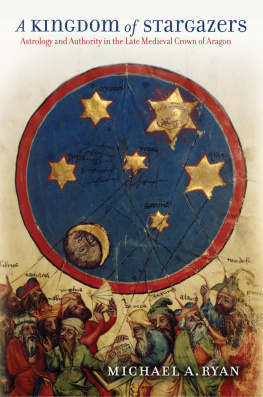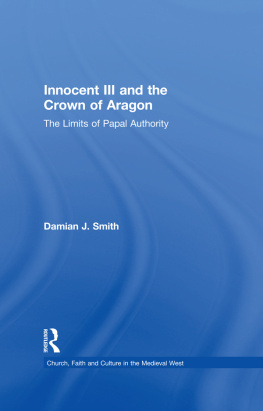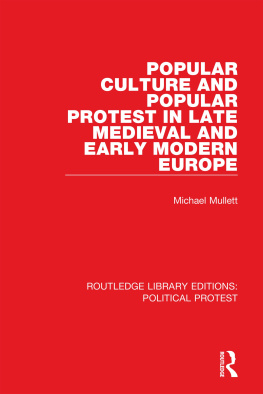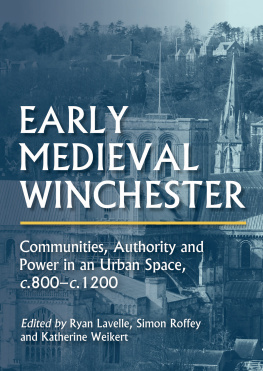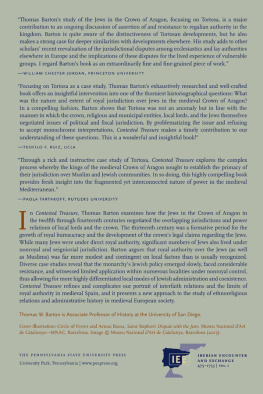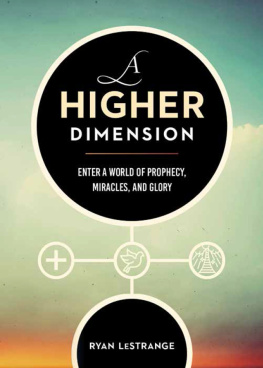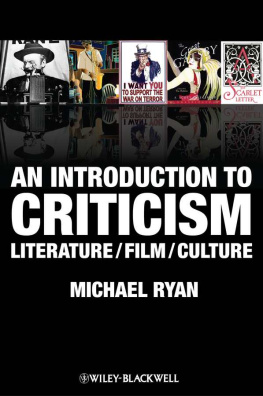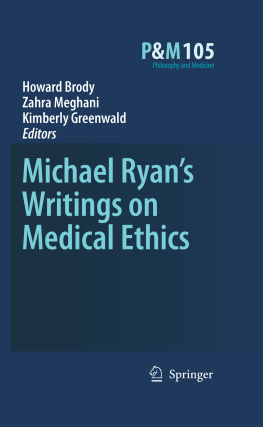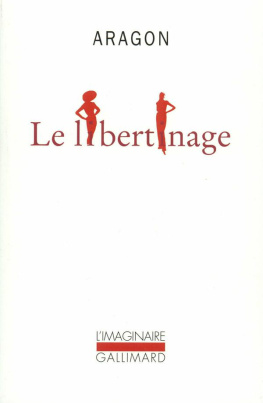Michael A. Ryan - A Kingdom of Stargazers: Astrology and Authority in the Late Medieval Crown of Aragon
Here you can read online Michael A. Ryan - A Kingdom of Stargazers: Astrology and Authority in the Late Medieval Crown of Aragon full text of the book (entire story) in english for free. Download pdf and epub, get meaning, cover and reviews about this ebook. year: 2011, publisher: Cornell University Press, genre: Religion. Description of the work, (preface) as well as reviews are available. Best literature library LitArk.com created for fans of good reading and offers a wide selection of genres:
Romance novel
Science fiction
Adventure
Detective
Science
History
Home and family
Prose
Art
Politics
Computer
Non-fiction
Religion
Business
Children
Humor
Choose a favorite category and find really read worthwhile books. Enjoy immersion in the world of imagination, feel the emotions of the characters or learn something new for yourself, make an fascinating discovery.
- Book:A Kingdom of Stargazers: Astrology and Authority in the Late Medieval Crown of Aragon
- Author:
- Publisher:Cornell University Press
- Genre:
- Year:2011
- Rating:5 / 5
- Favourites:Add to favourites
- Your mark:
- 100
- 1
- 2
- 3
- 4
- 5
A Kingdom of Stargazers: Astrology and Authority in the Late Medieval Crown of Aragon: summary, description and annotation
We offer to read an annotation, description, summary or preface (depends on what the author of the book "A Kingdom of Stargazers: Astrology and Authority in the Late Medieval Crown of Aragon" wrote himself). If you haven't found the necessary information about the book — write in the comments, we will try to find it.
Michael A. Ryan: author's other books
Who wrote A Kingdom of Stargazers: Astrology and Authority in the Late Medieval Crown of Aragon? Find out the surname, the name of the author of the book and a list of all author's works by series.
A Kingdom of Stargazers: Astrology and Authority in the Late Medieval Crown of Aragon — read online for free the complete book (whole text) full work
Below is the text of the book, divided by pages. System saving the place of the last page read, allows you to conveniently read the book "A Kingdom of Stargazers: Astrology and Authority in the Late Medieval Crown of Aragon" online for free, without having to search again every time where you left off. Put a bookmark, and you can go to the page where you finished reading at any time.
Font size:
Interval:
Bookmark:
Part I
In the modern world we have all but banished the supernatural to the margins of intellect, to the realm of superstition. Yet during the Middle Ages the spiritual and supernatural worlds were of unquestioned importance to the vast majority of people. Soldiers entered the battlefield only after having been blessed for protection from harm and for salvation should they fall. Families preparing to buy property or arrange for the marriage of a child needed the spiritual guidance and approval of patron saints. The ravages of war, famine, and diseaseperceived by some as the deeds of malevolent forces or punishment from an angry Godcould be mitigated by praying to benevolent spiritual guardians and intercessors. For the clergy and others in the literate minority, the Bible and the writings of the Church fathers spoke of a vengeful God who had no qualms about punishing mankind for its sins, sometimes by spectacular means. They wrote, edited, analyzed, and disseminated these lessons to the illiterate majority of medieval Christendom.
The decorative arts of cathedrals and churches, their stained-glass windows and stone sculptures, also illustrated the effects of leading a sinful life. The Last Judgment series of stained-glass windows in the fifteenth-century Catalan Gothic church of Santa Mara del Mar in Barcelona, for instance, horrifically depict the torments of hell that awaited a sinful populace. Created by the master Sever Desmanes de Avignon, the images are chilling, as demons prod and push a group of damned souls, glowing red as hot coals, into the mouth of hell while directing their gazes to the congregants who might behold them.
To soothe a wrathful God, mortals needed spiritual intercessors, beings who knew firsthand the temptations that humans faced and who resisted them successfully. After these holy people died, the surviving members of the Christian community recognized them as saintsindividuals whose prior lives attested to humanitys ability to overcome carnal enticements. During times of crisis, Christians remembered the pious actions of saints, invoking their protection and drawing inspiration for strength to press on. Saints were thus vital for the living world, responding to the spiritual needs of a generation.
Saints were not the only ones who were able to act as intermediaries with the supernatural. Among the living, visionaries and magicians were blessed with extraordinary powers to see beyond the present moment, revisiting the past and even glimpsing the secrets of the future. Not everyone, of course, could claim such abilities, and those who were seen to be genuine visionaries occupied a special but precarious place within society, because the medieval general populace regarded them with both awe and fear. In short, these individuals were both part of and separate from their larger community.
In Jewish and Christian reckoning, the ability to comprehend future events dated back to the biblical prophets. Daniel, Ezekiel, Isaiah, Ezra, By the fourteenth and fifteenth centuries, ecclesiastical authorities had become so wary of the occult that any claims whatsoever to divinatory insight were inherently suspect.
The theological logic behind the Churchs suspicion rested largely on three principles: the Bible already revealed any information about the course of the future that God wanted people to know; God had granted prophetic insight to the biblical prophets and saints but had ceased this practice in the present age; and, finally, whereas at present the Lord seldom, if ever, communicated prophetic visions, the devil was only too happy to take advantage of human weakness by deceiving the gullible with false visions.of crisis, the desire to peer into the future bordered on vanity, which imperiled ones soul. Moreover, demons stood ready to ensnare those humans who dabbled in the occult arts.
In addition to distinguishing between the prophetic and occult modes of revelation, educated people established basic distinctions between the disciplines of astrology and astronomy, both of which were linked to revelatory knowledge. Astronomy, as a science that required mathematical training, occupied an honored place as one of the seven liberal arts that comprised the medieval curriculum. Astrology, on the other hand, was more problematic in that it ventured beyond the firmer ground of empirical analysis. Nevertheless, the line dividing astrology from astronomy was far more blurred than it is today. In the seventh century the foremost Iberian intellectual authority, Isidore of Seville, maintained in his Etymologiae that there existed a partial overlap between the disciplines. Whereas astronomia applied to the study of the movements of the heavens and the stars, astrologia had a dual identity. One part was naturalis and concerned itself with the same principles as astronomia. The other part was superstitiosa , practiced by mathematici who cast nativity horoscopes and engaged in the thorny practice of predicting peoples characters by the stars.
Astrology could be linked with other forms of acceptable prophesying to provide legitimacy to a vision, yet it is fair to say that throughout the Middle Ages astrology was largely viewed as an illegitimate art, driven and encouraged by malevolent, supernatural entities.
It is essential, therefore, to grasp the fundamental disjunct that plagued the perception of the divinatory arts throughout the Middle Ages. On the one hand, divination of future events was legitimate insofar as prophecy was seen as divine revelation. On the other hand, divination achieved through magical or occult means was illicit, even dangerous. In the remainder of this chapter, I trace these fundamental distinctions as drawn by medieval authorities. I first turn my attention to three premier theological authorities, the aforementioned Augustine of Hippo, the thirteenth-century Dominican philosopher and theologian Thomas Aquinas, and his contemporary William of Auvergne. I discuss their particular issues with, and condemnations of, astrology and the occult. I address Aquinass position in particular detail because he, more than any other ecclesiastical authority, clarified the medieval distinctions among various forms of occult divination.
After my analysis of William of Auvergne, I turn my attention to the matter of prophecy. I return to the early Middle Ages and Iberia with a brief discussion of Beatus of Libana, one of the most important medieval writers on apocalyptic matters. Beatuss work was of particular importance in the history of medieval prophecy, as many subsequent claims to future knowledge were understood and created within an apocalyptic framework. I then turn to a renowned figure in the history of prophecy and apocalyptic expectations, the twelfth-century Calabrian abbot Joachim of Fiore. Finally, I end this chapter by analyzing the lesser known, yet important, late medieval apocalyptic visionary John of Rupescissa and a member of the royal family of the Crown of Aragon, Pere lInfant, both of whom were influenced profoundly by Joachims writings.
Let us first turn to the stars, as their role in divination and the magical arts occupied an uneasily reconciled space in the medieval worldview.
Augustine then continues to disparage peoples devotion to the stars as masters of their fate by citing the example of twins who, although born on the same day and in the same locale, nevertheless frequently have different destinies. He refers to the story of Nigidius, an ancient astrologer who used a potters wheel to demonstrate graphically this very issue. Spinning the wheel as fast as he could, Nigidius applied two spots of black ink in rapid succession to the whirling disk. Although it appeared that the marks were in the same place, when the wheel stopped its motions, there was a significant distance separating the two marks. Nigidiuss analogy was that because of the rapidity of the heavens movements, even if one twin were born immediately after his or her sibling, the vastness of heaven would determine their markedly different fates. For Augustine, this argument is more fragile than the pots made by the spinning of that wheel, and he cites as his proof the case of the biblical twins Jacob and Esau (193). After discussing their marked differences in physical appearance, personal character, and ultimate fates, Augustine questions the motives of astrologers:
Font size:
Interval:
Bookmark:
Similar books «A Kingdom of Stargazers: Astrology and Authority in the Late Medieval Crown of Aragon»
Look at similar books to A Kingdom of Stargazers: Astrology and Authority in the Late Medieval Crown of Aragon. We have selected literature similar in name and meaning in the hope of providing readers with more options to find new, interesting, not yet read works.
Discussion, reviews of the book A Kingdom of Stargazers: Astrology and Authority in the Late Medieval Crown of Aragon and just readers' own opinions. Leave your comments, write what you think about the work, its meaning or the main characters. Specify what exactly you liked and what you didn't like, and why you think so.

